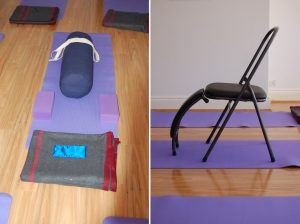 There is no doubt that foam blocks, non-slip sticky mats, bolsters, straps and yoga chairs were not part of the asana (postures) repertoire of the ancient yogis. While most yoga practioners have happily accepted the advantage of good quality yoga mats, the opinions on whether to use other accessories (‘props’) during yoga practice vary. Some schools of thought believe that we should only rely on our own ability to twist, extend and flex while others advocate that for many yoga students, correct anatomical alignment in a yoga posture is more easily and safely achieved with the use of props.
There is no doubt that foam blocks, non-slip sticky mats, bolsters, straps and yoga chairs were not part of the asana (postures) repertoire of the ancient yogis. While most yoga practioners have happily accepted the advantage of good quality yoga mats, the opinions on whether to use other accessories (‘props’) during yoga practice vary. Some schools of thought believe that we should only rely on our own ability to twist, extend and flex while others advocate that for many yoga students, correct anatomical alignment in a yoga posture is more easily and safely achieved with the use of props.
So, is all this extra ‘stuff’ just another marketing ploy to cash in on the ever-growing yoga community or is the use of props a natural evolution of yoga, adapting to the consequences of our sedentary lifestyle?
While yoga equipment is part of the commercial merchandise domain, there are absolutely good reasons to use and invest in some good quality props. Before I go into the more specific reasons why, let me give you a bit of a personal story how I came to use and appreciate props:
Having an inherent competitive personality, my yoga journey was very much driven by a minimalist and hard-core attitude, believing that all those things (blocks, bolsters) were for those (dare would I try one) ‘easy’, ‘restorative’ and ‘rehabilitative’ classes. It wasn’t until I was faced with a recurring back injury when the notion of back bends felt like an out-of-reach dream, that my partner Andrew suggested using a block to slowly open up my back in a relaxed way to prevent the painful muscle spasms. Not being able to do much else, the block became my saving grace and all those yoga journal articles on restorative poses, which I had skipped in the past, became essential reading material. Later on, an Iyengar yoga workshop with Glenn Ceresoli and a private yoga session with my teacher Noah Mckenna convinced me once and for all that blocks, bolsters, straps and yoga chairs are not only useful ‘crutches’ for advancing in our practice, but were important for successful rehabilitation of acute and chronic injuries.
Does this mean that in each yoga class we surround ourselves with props like a 5-year-old with Lego? The answer is “it depends.” It depends on the class that you are attending, the intentions and the knowledge on how to use these props intelligently. Props should not be used to contort or force you into otherwise impossible-to-achieve postures. If the body is not ready for a posture on a basic level, then props may do more harm than good.
The ultimate authority on (and probably the inventor of) modern yoga props is without doubt B.K.S Iyengar, one of the original students of Krishnamacharya. His definition of yoga props is “any object that helps to stretch, strengthen, relax or improve the alignment of the body. … Props allow asana to be practiced in a relaxed way, balancing the body and mind actively and passively.” He found that modern yoga students often benefit from additional assistance to develop the flexibility and strength required for postures that may have been once considered simple by ancient yogis. Sitting in chairs and in front of computer screens can lead to the shortening and locking of muscles and joints, affecting over all body movement and flexibility. Props can help to open these areas in a way that allows the student to relax into the posture.
Like with anything in life, the use of props comes down to personal choice – but it is highly likely that once you tasted the sweetness of backbends on a yoga chair or the deeper relaxation when reclined on a bolster, you won’t want to go back.
Have a happy practice 🙂
Namaste,
Evelyn

